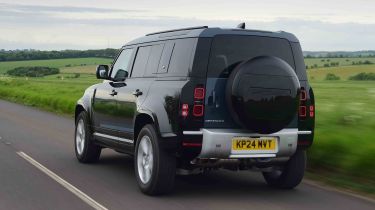Land Rover Defender - MPG, CO2 and running costs
No amount of hybrid technology makes the Land Rover Defender anything other than expensive to run

With such a bluff, upright profile and overall weight on the wrong side of two tonnes, the Defender isn’t going to be crossing continents on a single tank of fuel. Land Rover has added mild-hybrid tech to its 3.0-litre diesel engine to help improve efficiency, while there’s also the petrol plug-in hybrid to consider – although the high list price for that model may well deter some.
Choose any of the diesel-engined variants and the official average economy sits at around 33mpg. However, CO2 emissions are relatively high at over 220g/km.
The P425 petrol in the 90 bodystyle only manages 20.2mpg combined on the WLTP test cycle, and emissions of 316g/km. The plug-in hybrid P300e in the 110 bodystyle is able to return 103.8mpg, with CO2 emissions of 62g/km.
Unsurprisingly, the P500 and P525 V8 petrol engines are the least efficient options in the Defender range, capable of averaging around 20mpg at best in mixed driving conditions. What's more, CO2 emissions can average 329g/km. The more powerful Defender OCTA is actually more frugal than its supercharged siblings, with economy of 21.4mpg and CO2 emissions of 298g/km.
| Model | MPG | CO2 | Insurance group |
| Land Rover Defender P300e | 106.2mpg | 72g/km | 41E |
| Land Rover Defender 130 V8 P525 | 19.1mpg | 334g/km | 50E |
| Land Rover Defender 110 D350 | 33.2mpg | 240g/km | 41E |
Electric range, battery life and charge time
The Defender PHEV has the ability to rapid charge, so if you find the right charger (up to 40kW), you can refill a flat battery to 80 per cent in just 30 minutes. That’s quite an expensive way of fuelling the Defender, so most will do it via a 7kW wallbox charger at home using cheaper overnight electricity. Doing it this way will take about two and a half hours.
Used - available now

2022 Land Rover
Defender
75,923 milesAutomaticDiesel3.0L
Cash £40,000
2024 Land Rover
Defender
40,706 milesAutomaticPetrol3.0L
Cash £60,407
2024 Land Rover
Defender
24,752 milesAutomaticPetrol3.0L
Cash £78,000
2024 Land Rover
Defender
48,841 milesAutomaticDiesel3.0L
Cash £54,499If you can justify the relatively short 30-mile electric range of the plug-in P300e hybrid, then you may see some decent overall fuel economy numbers if you regularly charge it up and stick to short trips. However, when we lived with an older-specification P400e over nearly 13,000 miles, we averaged only 30mpg, which is close to what you’d expect from a diesel Defender – and that’s much cheaper to buy in the first place.
Company car drivers paying Benefit-in-Kind (BiK) tax may be tempted by its low average emissions of 61g/km. However, many alternatives, such as the BMW X5 xDrive50e, are in a much lower eight per cent band (at least until 2025). Then there is the all-electric seven-seat Kia EV9 to consider, offering much more space inside than a Defender, but costing even less per month.
| Model | Battery size | Range | Insurance group |
| Land Rover Defender P300e | 19.2kWh | 27 miles | 41E |
Tax
Every Defender is subject to premium road tax (applied to vehicles costing over £40,000), so while hybrid drive knocks £10 off the annual charge, it’s still an expensive car for Vehicle Excise Duty (VED).
Those concerned with company car tax will obviously veer towards the plug-in hybrid P300e model, which sits in the 19 per cent bracket due to its emissions of 72g/km, rather than its electric range.
Insurance groups
Premiums are going to be expensive for the Defender. Even the most basic Defender – a three-door 90 with the D250 engine – sits in insurance group 41 (out of 50), while the range-topping V8 falls into the highest insurance band.
There have been some historic issues with Land Rover owners getting insurance coverage for their cars, although the brand has been working hard on ways to improve theft resistance.
Depreciation
On the plus side, Defender owners will benefit from good residual values when the time comes to sell. Our latest expert data suggests that the Defender 90 retains between 53 to 67 per cent of its value over a typical three-year/36,000-mile ownership period. The 110 retains the most value (between 57 to 68 per cent), while the 130 is likely to lose the most, being worth between 47 to 55 per cent over the same ownership period.
That’s much better than the BMW X5, which will only retain between 40 to 53 per cent of its value over the same period.
To get an accurate valuation for a specific model, check out our valuation tool...








